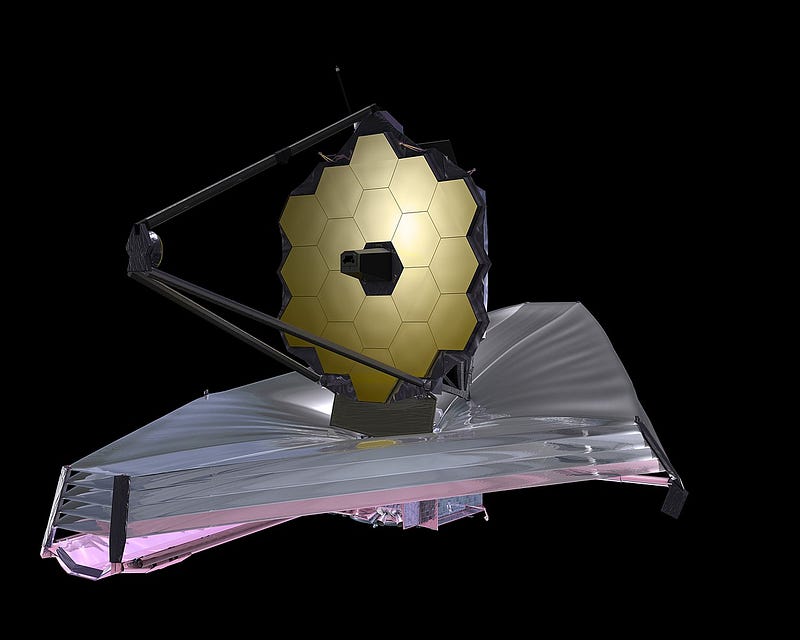Exploring the Cosmic Origins of Life: Webb Telescope Insights
Written on
Chapter 1: The Journey of the Webb Telescope
The Webb Space Telescope, renowned for its breathtaking images of celestial bodies within our solar system, has now expanded its reach into the farthest corners of the universe. NASA researchers have set their sights on a nascent planetary system located in the expansive Great Nebula of Orion, roughly 1,350 light years from Earth.

Nestled within this cosmic nursery is a developing star, encircled by a protoplanetary disk—a colossal assembly of swirling dust and gas. Gradually, these particles coalesce, leading to the formation of new planets. Within this stellar cradle, designated d203–506, scientists have identified a molecule called CH3+. This methyl carbocation, known for its fleeting and reactive nature, acts as a precursor to more complex organic compounds and is crucial as a fundamental building block of life.
Section 1.1: The Significance of Carbon in Life
Carbon stands as the foundation of life on Earth, forming the basis for all known organisms. Scientists propose that since carbon-based life emerged on our planet, similar processes could potentially occur in other solar systems and galaxies. In the quest for signs of life, researchers search for specific molecules like CH3+. This recent finding, documented in a Nature publication, illuminates the role of CH3+ in kickstarting organic chemistry in interstellar environments.
Subsection 1.1.1: Understanding CH3+
CH3+ shares similarities with methane, which is composed of one carbon atom and four hydrogen atoms. By removing a hydrogen atom along with a pair of electrons from methane, the CH3+ molecule is formed. Typically, this compound is transitory, acting as a participant in various chemical reactions.
The Webb Telescope, through its detailed observations, successfully identified the CH3+ molecule within the protoplanetary disk d203–506. “The discovery confirmed the detection of several key CH3+ emission lines,” as noted on NASA’s website. Simply put, the Telescope recognized the unique “fingerprints” emitted by this molecule in the form of infrared radiation from the Orion Nebula.
“This finding not only highlights the impressive sensitivity of the Webb Telescope but also validates the essential role of CH3+ in interstellar chemistry,” remarked Marie-Aline Martin-Drumel, a co-author of the research from the University of Paris-Saclay.

Chapter 2: The Role of Ultraviolet Radiation
While ultraviolet (UV) rays are often associated with harmful effects, they are believed to play a significant role in certain chemical reactions. Researchers think that the environment where the methyl carbocation was found is subjected to intense UV radiation from nearby young, hot stars.
Additionally, the scientists observed that d203–506 exhibited unique chemical traits compared to other protoplanetary disks, notably lacking any detectable water.
“This clearly demonstrates that UV radiation has the potential to significantly alter the chemistry within a protoplanetary disk,” stated Olivier Berné, the lead author of the study. “It could be crucial in the early chemical stages of life's origins,” Berné added, suggesting that UV radiation may influence the emergence of life.
This groundbreaking discovery paves the way for deeper understanding of the cosmic processes that lead to the origin of life. By uncovering the essential “bricks of life” hidden in the vastness of space, we gain valuable insights into the intricate chemistry that might shape worlds beyond our own.
The first video provides an overview of how the Space Telescope has detected carbon-based molecules on distant planets, enriching our understanding of planetary formation.
The second video discusses the formation of planets as observed by the James Webb Space Telescope, showcasing the significance of these findings in the context of cosmic evolution.
This exploration reminds us of the vast possibilities and interconnectedness of the universe, where even the smallest molecules can unlock the mysteries surrounding the origins of life.
Thank you for engaging with this article! If you found it informative, we would be grateful for your support through claps, donations, or tips, which enables us to continue creating valuable content.
